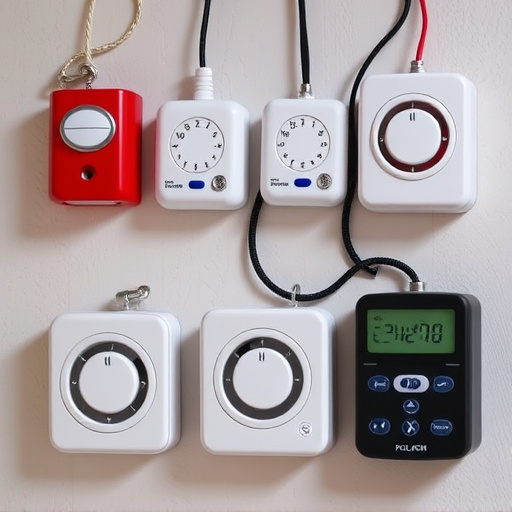As the population ages, wearable personal attack alarms offer innovative solutions for senior safety. Key features include adjustable sound ranges for discreet or noticeable alerts and automatic fall detection for quick emergency assistance. Customizable settings cater to individual needs, enhancing comfort while ensuring effective protection through powerful alarm sounds within a specified range. However, challenges like battery life and signal interference require regular monitoring for optimal performance.
With an increasing aging population, ensuring senior safety has become a paramount concern. Wearable security alarms offer a promising solution for peace of mind, providing immediate assistance during emergencies. This article explores the world of personal attack alarms designed specifically for seniors, highlighting their types, key features, installation, benefits, and potential challenges. From range to comfort, discover how these devices can empower elders while addressing their unique needs, ensuring a safer and more secure future.
- Understanding the Need for Senior Safety
- Types of Wearable Personal Attack Alarms
- Key Features to Consider in a Senior-Friendly Alarm
- Installation and Customization Options
- Benefits and Potential Challenges
Understanding the Need for Senior Safety
In today’s world, ensuring the safety and well-being of seniors is of utmost importance. As the population ages, the need for effective senior safety measures becomes increasingly apparent. Seniors may face unique challenges, including vulnerability to personal attacks due to reduced mobility or cognitive abilities. This growing concern has led to the development of innovative solutions, such as wearable security alarms, designed specifically to cater to their needs.
One of the key considerations is the range and effectiveness of these alarms. Personal attack alarm sound ranges should be optimized to ensure that help can be summoned promptly in case of an emergency. A reliable and loud alarm sound within a decent range can make all the difference in allowing seniors to get assistance quickly, enhancing their overall safety and peace of mind.
Types of Wearable Personal Attack Alarms
Wearable personal attack alarms for seniors come in various types, each designed with specific features to cater to different needs and preferences. One common type is the pendant alarm, often worn around the neck like a necklace. These devices are easy to activate, usually with a simple press of a button, and can emit a loud, attention-grabbing Personal Attack Alarm Sound within a good range, ensuring help arrives swiftly.
Another variety is the wristband alarm, akin to fitness trackers but with an added emergency function. These wristbands can detect falls and automatically alert caregiving services or preprogrammed contacts. The sound range for these devices may vary, offering both discreet and noticeable options depending on user preference and environment. Some advanced models even incorporate GPS tracking for accurate location sharing during emergencies.
Key Features to Consider in a Senior-Friendly Alarm
When choosing a wearable security alarm for seniors, several key features ensure comfort and peace of mind. First, consider a Personal Attack Alarm with a simple and intuitive design. This feature allows seniors to quickly trigger an alert in case of emergency, often through a subtle button press or even automatic fall detection.
Additionally, the Sound Range should be adjustable to accommodate different environments. A senior living alone might prefer a quieter alarm for home use, while a more robust sound is beneficial for those in assisted living facilities or shared spaces. This flexibility ensures the alarm remains effective yet unobtrusive, enhancing safety without compromising daily comfort.
Installation and Customization Options
When it comes to installing a wearable security alarm for seniors, there are various options available to suit individual needs and preferences. Many devices offer simple plug-and-play setups, where a small, discreet sensor is attached to clothing or worn directly on the body, connected to a base unit or mobile app. These systems can be easily customized, allowing users to select their preferred Personal Attack Alarm Sound from a range of options, ensuring a familiar and effective warning signal.
Furthermore, customization extends to the alarm’s sensitivity settings. Users can adjust the trigger range for the Personal Attack Alarm Sound, fine-tuning it to respond only when needed, whether in close proximity or at a distance. This flexibility is particularly beneficial for seniors who may have varying levels of mobility or specific requirements, enabling them to create a tailored safety solution that complements their daily routines.
Benefits and Potential Challenges
Wearable security alarms designed for seniors offer numerous benefits, enhancing their safety and peace of mind. These devices, often in the form of discrete wristbands or pendants, can emit a powerful Personal Attack Alarm Sound within a specified range to deter potential threats. The sound range typically allows for effective notification without causing distress to bystanders. Additionally, they provide immediate assistance through emergency response features, ensuring seniors receive help swiftly during an incident.
Despite these advantages, potential challenges exist. Battery life and signal interference are common concerns. Seniors or their caregivers may need to regularly monitor device maintenance and ensure clear communication channels to avoid false alarms or missed alerts. Moreover, personal preferences for alarm sounds and sensitivity settings should be considered to prevent excessive false triggers and ensure the comfort of the wearer.
Wearable security alarms for seniors offer a peace of mind that can significantly enhance their independence and safety. By understanding the specific needs of elderly individuals, choosing the right type of alarm with features like loud personal attack alarm sound ranges, and ensuring proper installation, these devices can be transformative in terms of senior care. While there may be challenges to consider, the benefits of enhanced mobility, personalized assistance, and timely help during emergencies make wearable alarms a valuable addition to any senior’s daily routine.
